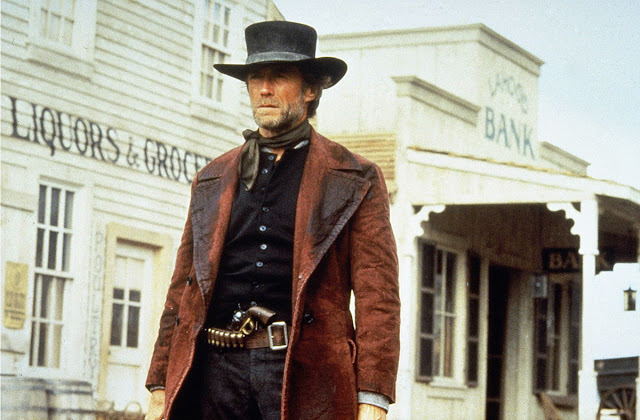Weird Westerns: Pale Rider (1985)
★★★★☆
Clint Eastwood's second film about a ghostly revenger, benefiting from
Eastwood's increased maturity as a filmmaker and from a script that
cribs heavily from the cowboy classic "Shane."
by Max Sparber
There was a 12-year gap between "High Plains Drifter" and "Pale Rider," Clint Eastwood's second ghostly revenger film, and it shows. "Pale Rider" is a more assured, less derivative, less pulpy film, lensed in a gorgeous naturalistic style.
It's also a far more compassionate movie. The earlier film was shot through with an unrelenting meanness, where everybody was cruel and miserable, including Eastwood's nameless character, who started the film with rape and murder and ended it with even more brutality.
It helps that the unacknowledged source material here is "Shane," the 1953 film featuring the unlikely friendship between a gunslinger and a little boy, which viewed killing as a terrible thing that sometimes men are forced to do in a lawless land, and something bad for the men who do it.
"Pale Rider" was commissioned by Eastwood, and it's hard to imagine what that discussion was like, because he wound up with a version of "Shane" where the gunfighter is a ghost, the little boy is now a young girl, and the young girl wants to sleep with the ghost.
This is mostly a terrific film — one of the best Weird Westerns ever made — and attempts to handle this teenage romance cautiously. Eastwood's character, a scowling preacher with bullet holes in his back, has no interest in her, and offers a gentle rebuke to her advances.
But the teen in question was Sydney Penny, the daughter of Western Swing great Hank Penny, who would grow into a strikingly beautiful woman, and it is hard to shrug off the sense that she is used in the movie for jailbait appeal. There is even a scene in which Chris Penn attempts to rape her, and, honestly, this just exceeds the bounds of ethical filmmaking for me. She is very much presented as a child on the verge of womanhood, and, well, she's 14.
She does not need to be in this film as a sexual character, even one who is protected and whose sexuality is rebuffed. Not by a film commissioned, lensed, and starring a 55-year-old man. "Shane" managed to be about an adult man and a boy without making the boy a sexual character; I think we are capable of doing the same with girls.
That complaint aside, "Pale Rider" is a finely observed film. Eastwood's supernatural presence (it is strongly alluded to him being a ghost) is presented in a carefully drawn world, a snowy mining community in Northern California made up of tents and rough wood structures dotting the side of a mountain like goats.
This is a small community of independent gold panners in a part of the world that has largely congealed under the control of one man, a miner who struck gold early enough to snatch up other mines, played with quiet contempt by Richard Dysart. He's a start contrast to the leader of the panners, a sweet, genially heroic character played by the terrific character actor Michael Moriarty.
Moriarty is on the right side of our sympathies but the wrong side of history, desperately holding on to a claim for a small patch of land that a rich man wants, a man who is shearing the tops off all local mountains with high pressure water, a man who has enough money to hire goons who claim to be the law and for them to kill whoever is in their way.
Unfortunately for them, this is a ghost story, and the film's grim ghost, played by Eastwood, has no compunctions about killing anything that moves and dynamiting anything that doesn't. This is a lot of this in the movie, and it's well-done, although it lacks the real nauseating fear at the core of "Shane," that our likeable gunfighter might not survive his climactic gunfight, and, if he does, he might still be destroyed by it.
Still, "Pale Rider" maintains "Shane's" sense of outraged justice, its gimlet look at a world in which men and women who work honestly, work hard, and work together are just insignificant irritants to those who already have made fortunes — and irritants that can be murdered without conscience.
While the earlier film focused on a character who is outside the law, and capable of lawless violence, and was therefor able to do the terrible thing required in a place where civilization was just taking hold, Eastwood's film seems more cynical.
In "Pale Rider," there is no human cure for capitalist violence. No, the only thing that will prevent the rich from destroying the poor is a ghost.



Quick comment: you swapped "High Plains Drifter" for "Pale Rider" in the first sentence of paragraph eight. Great review, otherwise.
ReplyDelete"Pale Rider" was one of the first DVDs I ever purchased. I respect and enjoy Eastwood's film career, but I agree with the points you call him out on here and in his earlier western.